Introduction to Leg Strengthening Exercises for Seniors: Purpose and Importance
As we age, maintaining strength and mobility becomes crucial for leading a healthy and independent life. One key aspect of this is focusing on leg strengthening exercises for seniors. Strengthening the legs isn’t just about enhancing physical appearance; it’s about improving overall well-being, increasing mobility, enhancing balance, and boosting the quality of life. In this article, we’ll delve into why leg strengthening is so important for seniors and offer a comprehensive guide on how to effectively incorporate these exercises into daily routines.
Purpose and Importance of Leg Strengthening Exercises for Seniors
Leg strengthening exercises for seniors are essential for several reasons. As we grow older, our muscles naturally lose mass and strength, a condition known as sarcopenia. This muscle loss can lead to decreased mobility, balance issues, and a higher risk of falls, which are a major cause of injury among older adults. By focusing on leg strengthening, seniors can counteract these effects and enjoy a more active and fulfilling life.
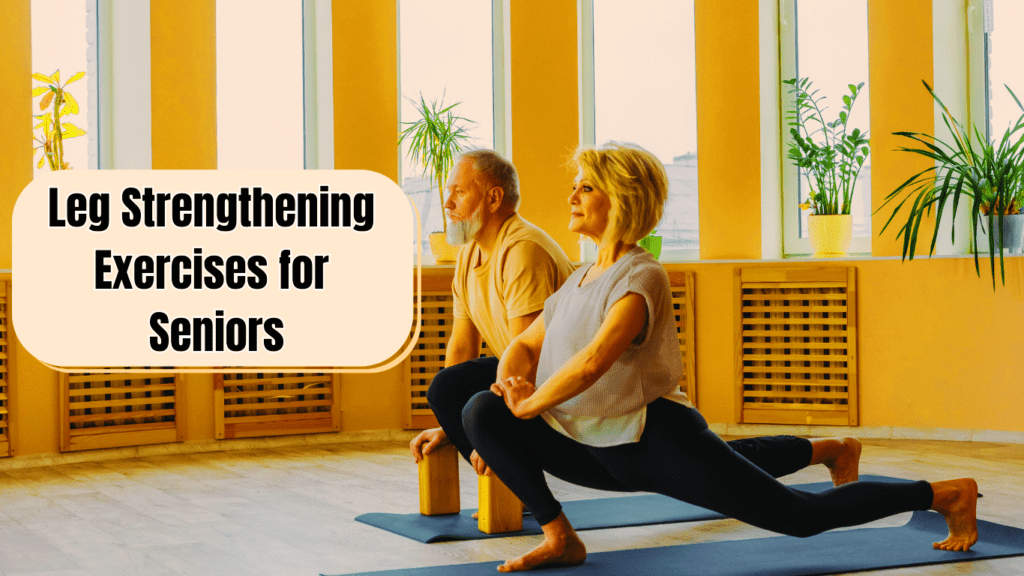
Improved mobility is one of the primary benefits of leg strengthening exercises for seniors. Stronger leg muscles make it easier to perform daily activities such as walking, climbing stairs, and getting up from a chair. This increased mobility helps seniors maintain their independence and reduces the need for assistance in everyday tasks.
Balance is another critical aspect that improves with leg strengthening exercises for seniors. Strong leg muscles provide a stable foundation, making it easier to stay upright and avoid falls. Falls are a leading cause of injury among seniors, and they can lead to severe consequences, including fractures and a decreased ability to live independently. By improving leg strength, seniors can enhance their balance and significantly reduce the risk of falls.
Moreover, engaging in regular leg strengthening exercises for seniors can lead to a better overall quality of life. Physical activity, including strength training, has been linked to improved mental health, better sleep, and increased energy levels. Seniors who exercise regularly often experience a sense of accomplishment and improved self-esteem, contributing to a more positive outlook on life.
In this article, we’ll cover various aspects of leg strengthening for seniors, providing a comprehensive guide to help you get started and stay motivated. Here’s a quick preview of what we’ll be discussing:
- Understanding the Importance of Leg Strength: We will delve deeper into why leg strength is crucial for seniors, examining the specific benefits and addressing common concerns.
- Preparing for Exercise: Before diving into exercises, it’s essential to prepare properly. We’ll cover warm-up routines, safety tips, and how to set realistic goals.
- Key Principles for Effective Leg Exercises: Learn about the foundational principles that make leg exercises effective, including the importance of proper form and gradual progression.
- Detailed Leg Strengthening Exercises: We’ll provide detailed instructions for a variety of exercises, suitable for different fitness levels and abilities.
- Incorporating Balance and Flexibility Training: Alongside strength training, we’ll discuss how to incorporate balance and flexibility exercises to create a well-rounded fitness routine.
- Creating a Personalized Exercise Plan: Every individual is unique, and we’ll guide you on how to tailor an exercise plan to meet your specific needs and goals.
- Staying Motivated and Engaged: Keeping up with a fitness routine can be challenging. We’ll offer tips and strategies to stay motivated and make exercise a regular part of your life.
- Addressing Challenges and Providing Solutions: Finally, we’ll address common challenges seniors may face when engaging in leg strengthening exercises and provide practical solutions to overcome them.
By understanding the purpose and importance of leg strengthening exercises for seniors, you can take the first step towards a healthier and more active lifestyle. Whether you’re looking to improve your mobility, enhance your balance, or simply boost your overall quality of life, incorporating these exercises into your daily routine can make a significant difference. Stay tuned as we explore each of these topics in detail, providing you with the knowledge and tools you need to succeed.
Understanding the Importance of Leg Strength
Leg strengthening exercises for seniors are vital for maintaining health, independence, and overall well-being. Understanding the importance of leg strength can motivate you to incorporate these exercises into your daily routine and enjoy the numerous benefits they offer. In this section, we will discuss the health benefits of leg strengthening exercises and address common concerns that seniors might have about starting a leg strengthening regimen.
Health Benefits of Leg Straightening Exercises for Seniors
One of the primary health benefits of leg strengthening exercises for seniors is fall prevention. As we age, our muscles naturally weaken, and our balance can deteriorate, increasing the risk of falls. Falls are a leading cause of injury among seniors, often resulting in fractures, hospitalizations, and a decreased ability to live independently. By engaging in regular leg strengthening exercises, seniors can build stronger muscles that provide better support and stability, significantly reducing the risk of falls. Strong leg muscles contribute to better balance and coordination, making everyday movements safer and more controlled.
Leg Exercises For Seniors Video
Improved circulation is another critical health benefit of leg strengthening exercises for seniors. Poor circulation can lead to various health issues, including swelling, pain, and an increased risk of blood clots. Engaging in leg exercises helps to enhance blood flow, ensuring that oxygen and nutrients are efficiently delivered to the tissues. This improved circulation can alleviate symptoms of poor blood flow, promote healing, and reduce the risk of developing circulation-related conditions. Additionally, better circulation contributes to overall cardiovascular health, supporting heart function and reducing the likelihood of cardiovascular diseases.
Enhanced independence is a significant outcome of incorporating leg strengthening exercises into a senior’s routine. Stronger leg muscles enable seniors to perform daily activities with greater ease and confidence. Tasks such as walking, climbing stairs, and getting up from a chair become less challenging, allowing seniors to maintain their independence for a longer period. This independence is crucial for mental and emotional well-being, as it fosters a sense of self-reliance and reduces the need for assistance from others. By staying active and mobile, seniors can continue to engage in social activities, hobbies, and community events, enhancing their overall quality of life.
Common Concerns
While the benefits of leg strengthening exercises for seniors are clear, it’s natural to have concerns about starting a new exercise regimen. Safety is often the foremost concern. Seniors might worry about the risk of injury or exacerbating pre-existing conditions. It’s important to remember that leg strengthening exercises can be adapted to suit individual needs and fitness levels. Starting with low-impact exercises and gradually increasing intensity can help minimize the risk of injury. Additionally, consulting with a healthcare provider before beginning any new exercise program is crucial, especially for those with pre-existing conditions or chronic illnesses. A healthcare professional can provide personalized advice and ensure that the chosen exercises are safe and effective.
Pre-existing conditions are another common concern among seniors considering leg strengthening exercises. Conditions such as arthritis, osteoporosis, and joint pain might make some exercises seem daunting. However, many leg strengthening exercises can be modified to accommodate these conditions. For example, exercises that focus on gentle stretching and low-impact movements can help improve strength without putting undue stress on the joints. Water-based exercises, such as water aerobics, are also excellent options for individuals with joint pain, as the buoyancy of water reduces the impact on the joints while providing resistance for muscle strengthening. Working with a physical therapist or a certified fitness trainer who has experience with seniors can also provide valuable guidance and support in designing a safe and effective exercise plan.
Another concern is the fear of overexertion. Seniors might worry about pushing themselves too hard and experiencing fatigue or soreness. It’s essential to listen to your body and start slowly, gradually increasing the duration and intensity of the exercises. Rest and recovery are vital components of any exercise routine, so ensure that you allow your muscles adequate time to recover between sessions. Incorporating a variety of exercises that target different muscle groups can also help prevent overexertion and keep the routine enjoyable and balanced.
Motivation is a crucial factor in maintaining a consistent exercise routine. Some seniors might find it challenging to stay motivated, especially if they are new to exercise or have had negative experiences in the past. Setting realistic and achievable goals can help maintain motivation. Celebrating small achievements and progress can provide a sense of accomplishment and encourage continued effort. Additionally, exercising with a friend or joining a group fitness class can make the experience more enjoyable and provide social support. The benefits of leg strengthening exercises for seniors extend beyond physical health, contributing to mental and emotional well-being by fostering a sense of community and connection.
In conclusion, understanding the importance of leg strength and addressing common concerns can empower seniors to incorporate leg strengthening exercises into their daily routines. The health benefits, including fall prevention, improved circulation, and enhanced independence, make these exercises a valuable addition to a senior’s lifestyle. By taking a cautious and informed approach, seniors can safely and effectively improve their leg strength, enjoy greater mobility, and enhance their overall quality of life. As we continue to explore the various aspects of leg strengthening exercises, we’ll provide detailed guidance on preparing for exercise, effective exercise techniques, and creating a personalized plan to meet individual needs and goals. Stay motivated, stay active, and embrace the journey to a stronger and healthier you.
Leg Strengthening Exercises for Seniors: Key Insights
| Age Group | Primary Benefits | Supporting Activities | Exercise Frequency | Exercise Intensity | Common Concerns | Modifications |
|---|---|---|---|---|---|---|
| 60-70 | Enhanced mobility, fall prevention | Walking, cycling | 3-4 times/week | Moderate | Joint pain | Low-impact, water-based exercises |
| 70-80 | Balance, independence | Chair exercises, yoga | 3 times/week | Moderate | Arthritis | Use support, reduce range of motion |
| 80+ | Stability, circulation | Seated leg lifts, gentle stretching | 2-3 times/week | Light | Fatigue, osteoporosis | Slow pace, avoid heavy resistance |
Preparing for Exercise
Before beginning any new exercise regimen, especially one that involves leg strengthening exercises for seniors, it is crucial to prepare properly. Adequate preparation ensures safety, maximizes the benefits of the exercises, and helps prevent injury. This section will cover the essential steps in preparing for exercise, including consulting with healthcare providers and incorporating proper warm-up and cool-down routines.
Consulting with Healthcare Providers
The first step in preparing for any exercise program, particularly leg strengthening exercises for seniors, is to consult with a healthcare provider. This step is essential to ensure that the exercises are safe and appropriate for your specific health condition. Seniors often have unique health considerations such as arthritis, osteoporosis, cardiovascular conditions, or previous injuries that need to be taken into account when designing an exercise plan.
A healthcare provider can perform a comprehensive health assessment, considering your medical history, current medications, and any chronic conditions. This assessment helps in identifying any potential risks associated with starting a new exercise regimen. The provider can then offer personalized advice and modifications to ensure that the exercises are safe and effective for your specific situation. Additionally, they may recommend specific exercises that are most beneficial for you or suggest working with a physical therapist or a certified fitness trainer who has experience with seniors.
It’s important to communicate openly with your healthcare provider about your goals and any concerns you may have. By doing so, you can collaboratively develop an exercise plan that aligns with your health status and fitness objectives. This step not only ensures your safety but also provides peace of mind, knowing that you are taking the right approach to improve your leg strength.
Warm-Up and Cool-Down
Incorporating a proper warm-up and cool-down routine is a critical aspect of preparing for leg strengthening exercises for seniors. These routines help to prepare your body for exercise, enhance performance, and reduce the risk of injury. Here’s a detailed guide on how to effectively warm up and cool down before and after your exercises.
Warm-Up
A good warm-up routine gradually increases your heart rate, loosens up your muscles, and prepares your body for more intense physical activity. For seniors, it’s important to keep the warm-up gentle and focused on mobility and flexibility.
Start with Light Cardio: Begin your warm-up with 5-10 minutes of light cardio activities. This could include walking at a moderate pace, marching in place, or gentle cycling on a stationary bike. The goal is to get your blood flowing and gradually elevate your heart rate.
Gentle Stretches: After the initial cardio, move on to some gentle stretches to prepare your muscles and joints. Focus on the major muscle groups in your legs, such as the quadriceps, hamstrings, calves, and hip flexors. Hold each stretch for about 15-30 seconds, and make sure to stretch both sides of your body evenly. Here are a few examples of effective stretches:
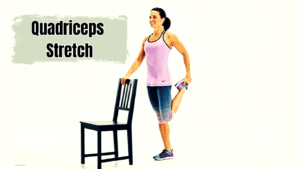
- Quadriceps Stretch: Stand behind a chair and hold onto it for balance. Lift your right foot towards your buttocks and hold your ankle with your right hand. Keep your knees close together and gently pull your foot towards your buttocks until you feel a stretch in the front of your thigh. Hold for 15-30 seconds and repeat on the other side.
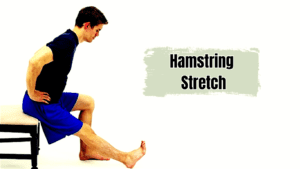
- Hamstring Stretch: Sit on the edge of a chair with one leg extended straight out in front of you, heel on the floor. Keep your back straight and lean forward slightly from the hips until you feel a stretch in the back of your thigh. Hold for 15-30 seconds and switch legs.
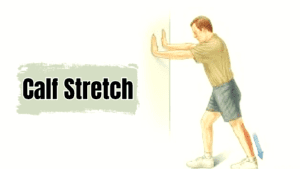
- Calf Stretch: Stand facing a wall with your hands placed on the wall for support. Step one foot back and press the heel into the floor, keeping the back leg straight and the front knee slightly bent. Hold the stretch for 15-30 seconds and switch legs.
Joint Mobilization: Perform some gentle joint mobilization exercises to increase flexibility and range of motion. These can include ankle circles, hip circles, and knee lifts. Aim for 8-10 repetitions of each exercise, moving slowly and smoothly.
Cool-Down
A proper cool-down routine helps to gradually lower your heart rate, prevent muscle stiffness, and promote recovery after exercise. Cooling down is especially important after leg strengthening exercises for seniors to ensure that the muscles are adequately stretched and relaxed.
Light Cardio: Begin your cool-down with 5-10 minutes of light cardio activities similar to your warm-up. This helps to gradually decrease your heart rate and breathing rate.
Static Stretches: After the light cardio, move on to static stretches. These are stretches that you hold in one position for a prolonged period, usually 15-30 seconds. Focus on the same muscle groups you targeted during the warm-up, ensuring that each muscle is gently stretched and relaxed. Here are a few examples:
- Calf Stretch: Repeat the calf stretch from the warm-up, holding each stretch for 15-30 seconds.
- Hamstring Stretch: Sit on the floor with both legs extended straight out in front of you. Reach forward towards your toes, keeping your back straight, until you feel a stretch in the back of your thighs. Hold for 15-30 seconds.
- Hip Flexor Stretch: Kneel on the floor with one foot forward and the other knee on the ground. Shift your weight forward slightly until you feel a stretch in the front of your hip. Hold for 15-30 seconds and switch legs.
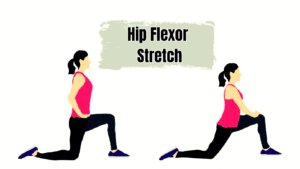
Breathing Exercises: Incorporate some deep breathing exercises to help relax your body and mind. Sit or lie down in a comfortable position and take slow, deep breaths, inhaling through your nose and exhaling through your mouth. Focus on making each breath slow and deliberate, helping to calm your nervous system and promote relaxation.
Hydration and Nutrition: After completing your cool-down routine, it’s important to rehydrate and refuel your body. Drink plenty of water to replace fluids lost during exercise, and consider having a small snack that includes protein and carbohydrates to support muscle recovery.
By following these steps and incorporating a thorough warm-up and cool-down routine, you can prepare your body for leg strengthening exercises for seniors and reduce the risk of injury. Proper preparation ensures that you get the most out of your exercise routine, enhancing your leg strength and overall fitness safely and effectively. As we move forward, we’ll explore key principles for effective leg exercises and provide detailed instructions for various exercises suitable for seniors. Stay committed to your exercise journey, and you’ll soon see the benefits of stronger legs and improved mobility.
Key Principles for Effective Leg Strengthening Exercises for Seniors
When it comes to leg strengthening exercises for seniors, it is essential to follow key principles that ensure safety, effectiveness, and long-term benefits. Understanding and applying these principles can help seniors maximize the benefits of their workouts while minimizing the risk of injury. This section will discuss safety first, proper form and technique, and the importance of progression and consistency.
Safety First
Safety should always be the top priority when performing leg strengthening exercises for seniors. Here are some critical safety tips to keep in mind:
Using Supportive Shoes: Wearing the right shoes can make a significant difference in your exercise experience. Supportive shoes provide stability, reduce the risk of slipping, and help maintain proper alignment of the feet and legs. Choose shoes with good arch support, cushioning, and a non-slip sole to ensure maximum comfort and safety during your exercises.
Exercising on Even Surfaces: Performing exercises on an even, stable surface is crucial for preventing falls and injuries. Avoid exercising on uneven or slippery surfaces, as they can increase the risk of losing balance. If possible, use a mat or carpeted area for additional support and cushioning.
Ensuring Proper Hydration: Staying hydrated is essential, especially during physical activity. Dehydration can lead to dizziness, fatigue, and muscle cramps, which can increase the risk of injury. Make sure to drink plenty of water before, during, and after your exercise sessions. Keep a water bottle nearby and take regular sips to stay hydrated.
Proper Form and Technique
Maintaining proper form and technique is crucial for preventing injuries and maximizing the effectiveness of leg strengthening exercises for seniors. Here’s how to ensure you’re using the correct form:
Start Slowly: Begin with simple exercises that you are comfortable with and gradually progress to more challenging ones. This approach allows your body to adapt and helps you learn the correct form without feeling overwhelmed.
Focus on Alignment: Proper alignment is essential for preventing strain on your joints and muscles. Keep your feet hip-width apart, your knees slightly bent, and your back straight. Engage your core muscles to support your lower back and maintain stability.
Controlled Movements: Perform each exercise with slow, controlled movements. Avoid rushing through the exercises, as this can lead to poor form and increase the risk of injury. Concentrate on each movement and ensure that you are engaging the correct muscles.
Use a Mirror: Exercising in front of a mirror can help you monitor your form and make adjustments as needed. It allows you to see if you are maintaining the correct alignment and making controlled movements.
Listen to Your Body: Pay attention to how your body feels during each exercise. If you experience any pain or discomfort, stop immediately and reassess your form. It’s normal to feel some muscle fatigue, but sharp pain or discomfort is a sign that something is wrong.
Progression and Consistency
Gradual progression and consistency are key to making lasting improvements in leg strength. Here’s how to incorporate these principles into your routine:
Gradual Progression: Start with low-intensity exercises and gradually increase the intensity and duration over time. This gradual progression allows your muscles to adapt and grow stronger without becoming overwhelmed. For example, if you’re starting with chair squats, begin with a few repetitions and gradually increase the number as you become more comfortable.
Set Realistic Goals: Setting realistic, achievable goals can help you stay motivated and track your progress. Start with small, attainable goals and gradually work towards more challenging ones. For example, aim to perform a certain number of repetitions or complete a specific exercise routine a few times a week.
Consistency is Key: Maintaining a consistent exercise routine is crucial for achieving long-term benefits. Aim to perform leg strengthening exercises for seniors at least 2-3 times a week. Consistency helps build muscle strength, improve balance, and enhance overall fitness. Find a routine that works for you and stick to it.
Variety in Exercises: Incorporating a variety of exercises into your routine can help target different muscle groups and prevent boredom. Mix up your routine with exercises such as leg lifts, seated marches, and calf raises. This variety keeps your workouts interesting and ensures that you are working all the major muscle groups in your legs.
Tracking Progress: Keep track of your progress by noting the exercises you perform, the number of repetitions, and how you feel after each session. Tracking your progress helps you see improvements over time and stay motivated. It also allows you to identify any areas where you might need to make adjustments.
Listen to Your Body: Your body will give you signals if you are pushing too hard or if an exercise is not suitable for you. Pay attention to these signals and make adjustments as needed. Rest and recovery are just as important as the exercises themselves. Make sure to give your muscles time to recover between sessions.
Staying Motivated: Finding ways to stay motivated is essential for maintaining a consistent exercise routine. Exercise with a friend or join a fitness class to make the experience more enjoyable. Celebrate your achievements, no matter how small, and remind yourself of the benefits of leg strengthening exercises for seniors. Improved mobility, balance, and overall quality of life are worth the effort.
Following these key principles—safety first, proper form and technique, and progression and consistency—can help seniors effectively and safely perform leg strengthening exercises for seniors. By incorporating these principles into your routine, you can enhance your leg strength, improve your overall fitness, and enjoy a better quality of life. As we continue to explore the various aspects of leg strengthening exercises, we will provide detailed instructions for specific exercises suitable for seniors. Stay dedicated to your exercise journey, and you’ll soon experience the many benefits of stronger, healthier legs.
Detailed Leg Strengthening Exercises for Seniors
Incorporating effective leg strengthening exercises for seniors into your routine can significantly improve mobility, balance, and overall quality of life. This section will provide detailed instructions, benefits, and modifications for various exercises designed to strengthen the legs. These exercises are tailored to accommodate different fitness levels and mobility capabilities, ensuring that seniors can safely and effectively perform them.
Chair Squats: Leg Strengthening Exercises for Seniors
Chair squats are an excellent way to strengthen the quadriceps, hamstrings, and glutes. They are particularly beneficial because they mimic the motion of sitting and standing, a movement essential for daily activities.
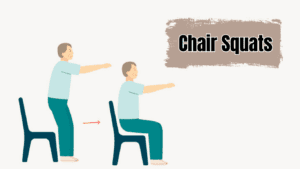
Instructions:
- Positioning: Stand in front of a sturdy chair with your feet hip-width apart.
- Lowering: Slowly bend your knees and push your hips back as if you are going to sit down. Keep your back straight and your weight on your heels.
- Sitting: Lower yourself until you are just about to touch the chair with your buttocks. Hold this position for a moment.
- Rising: Push through your heels and slowly return to the standing position.
Benefits: Chair squats improve lower body strength, enhance balance, and help with functional movements like standing up from a seated position.
Modifications: If you find this exercise challenging, you can start by actually sitting down and then standing up. Use the chair for support if needed and gradually progress to hovering above the chair without sitting.
Leg Lifts:Leg Strengthening Exercises for Seniors
Leg lifts target the muscles in your legs and core. There are several variations, including side, front, and back leg lifts.
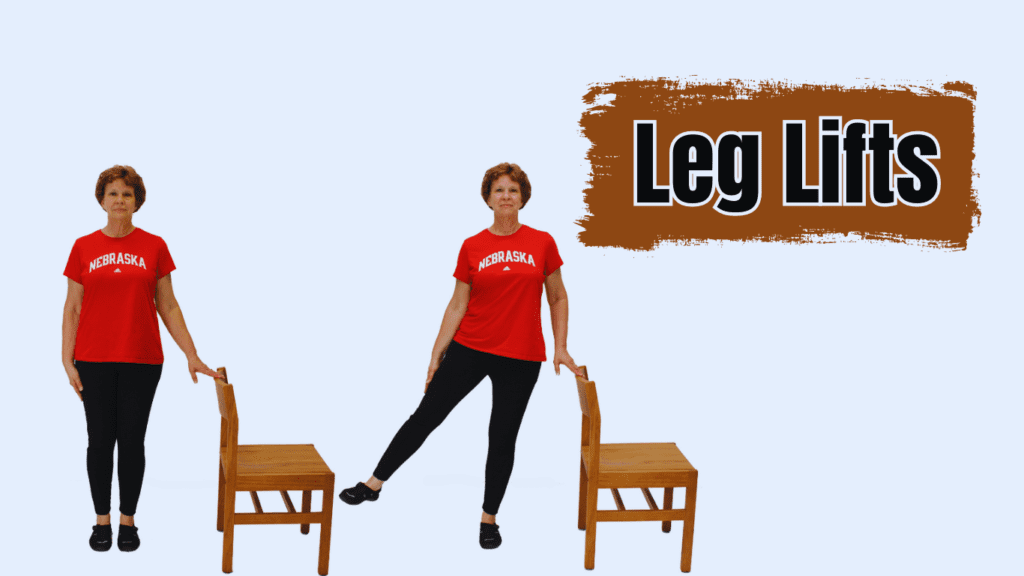
Side Leg Lifts:
- Positioning: Stand next to a chair or counter for support.
- Lifting: Slowly lift your right leg out to the side, keeping it straight. Avoid leaning to the opposite side.
- Holding: Hold for a moment and then slowly lower your leg back down.
- Repetition: Repeat 10-15 times on each leg.
Front Leg Lifts:
- Positioning: Stand behind a chair for support.
- Lifting: Lift your right leg straight forward, keeping your knee straight.
- Holding: Hold for a moment and then slowly lower your leg.
- Repetition: Repeat 10-15 times on each leg.
Back Leg Lifts:
- Positioning: Stand behind a chair for support.
- Lifting: Lift your right leg straight back without bending your knee or leaning forward.
- Holding: Hold for a moment and then slowly lower your leg.
- Repetition: Repeat 10-15 times on each leg.
Benefits: These exercises improve muscle strength, enhance balance, and increase flexibility in the legs and hips.
Modifications: If you experience balance issues, perform these exercises while seated, lifting one leg at a time.
Heel and Toe Raises
Heel and toe raises strengthen the calf muscles and improve balance.

Instructions:
- Positioning: Stand with your feet hip-width apart, using a chair or counter for support.
- Heel Raises: Slowly rise up onto your toes, lifting your heels off the ground. Hold for a few seconds.
- Lowering: Slowly lower your heels back to the ground.
- Toe Raises: Lift your toes off the ground, rocking back onto your heels. Hold for a few seconds and then lower your toes back down.
- Repetition: Perform 10-15 repetitions of each.
Benefits: These exercises enhance calf strength, improve balance, and help with walking stability.
Modifications: Perform these exercises while seated if standing is too challenging.
Seated Marching
Seated marching is an excellent exercise for those with limited mobility. It helps strengthen the hip flexors and improves circulation.
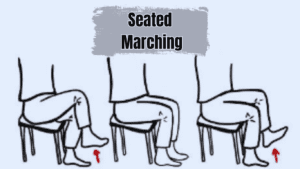
Instructions:
- Positioning: Sit in a sturdy chair with your feet flat on the floor.
- Lifting: Lift your right knee towards your chest as high as comfortable.
- Lowering: Lower your right foot back to the ground and repeat with your left leg.
- Repetition: Continue alternating legs for 20-30 repetitions.
Benefits: This exercise improves hip flexor strength, enhances circulation, and can help maintain joint mobility.
Modifications: Lift your legs only as high as is comfortable and gradually increase the height over time.
Step-Ups
Step-ups are a functional exercise that mimics the action of climbing stairs, which is beneficial for daily activities.

Instructions:
- Positioning: Stand in front of a step or sturdy platform.
- Stepping Up: Step up onto the platform with your right foot, followed by your left foot.
- Stepping Down: Step down with your right foot first, followed by your left foot.
- Repetition: Repeat 10-15 times on each leg.
Benefits: Step-ups strengthen the quadriceps, hamstrings, and glutes. They also improve balance and coordination.
Safety Tips: Use a handrail or wall for support if needed. Ensure the platform is stable and not too high.
Resistance Band Exercises
Resistance band exercises provide an effective way to strengthen the legs with minimal equipment. One example is the seated leg press.
Seated Leg Press:
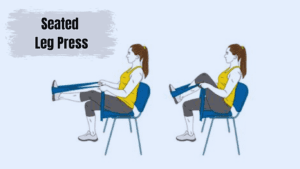
- Positioning: Sit in a chair with a resistance band looped around your feet.
- Pressing: Hold the ends of the band and press your feet forward, extending your legs.
- Returning: Slowly return to the starting position.
- Repetition: Perform 10-15 repetitions.
Benefits: Resistance band exercises improve muscle strength, enhance flexibility, and can be easily adjusted for different resistance levels.
Safety Tips: Ensure the resistance band is securely anchored and in good condition to prevent snapping.
Wall Sits
Wall sits are a static exercise that builds strength in the quadriceps, hamstrings, and glutes.
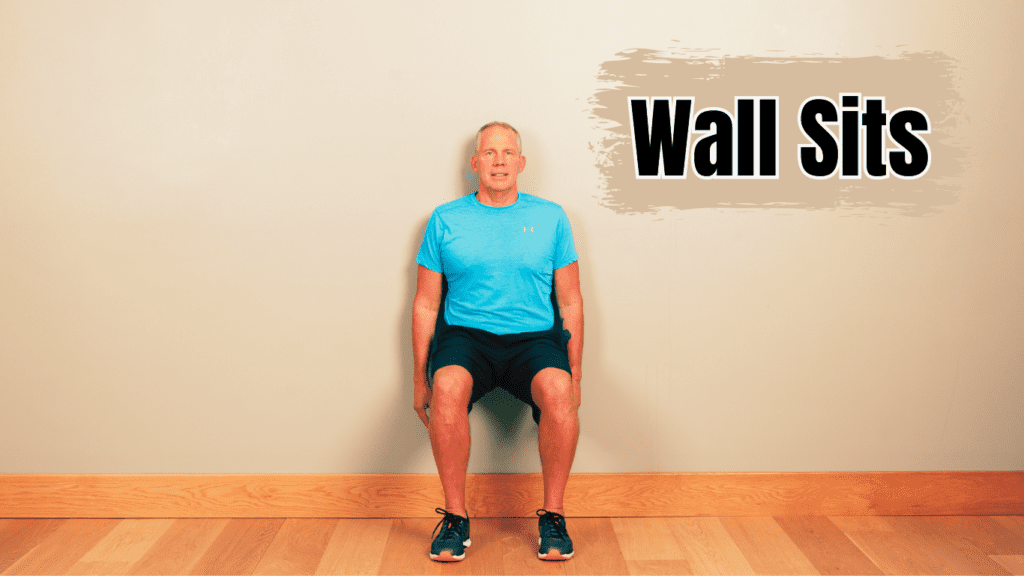
Instructions:
- Positioning: Stand with your back against a wall and feet shoulder-width apart.
- Lowering: Slide down the wall until your thighs are parallel to the ground, as if you are sitting in an invisible chair.
- Holding: Hold this position for as long as comfortable, starting with 10-15 seconds and gradually increasing over time.
- Rising: Push through your heels to slide back up to the starting position.
Benefits: Wall sits improve lower body strength and endurance. They also enhance balance and stability.
Tips for Proper Technique: Keep your back flat against the wall and your knees directly above your ankles. Avoid letting your knees extend past your toes.
By incorporating these detailed leg strengthening exercises for seniors into your routine, you can significantly enhance your lower body strength, balance, and overall mobility. Remember to perform each exercise with proper form and technique, gradually increase the intensity, and stay consistent with your workouts. As you continue to practice these exercises, you will likely notice improvements in your ability to perform daily activities and maintain an active lifestyle.
Incorporating Balance and Flexibility Training
In addition to leg strengthening exercises for seniors, incorporating balance and flexibility training is crucial for maintaining overall physical health and independence. Balance exercises help prevent falls, a common concern for seniors, while flexibility exercises ensure that muscles remain supple and joints stay limber, enhancing mobility and reducing the risk of injuries. This section will provide detailed instructions for simple balance exercises and effective flexibility routines, tailored specifically for seniors.
Balance Exercises
Balance exercises are essential for improving stability and coordination, which are vital for daily activities. These exercises can be performed with minimal equipment and can be easily integrated into a daily routine.
Standing on One Leg:
- Positioning: Stand next to a chair or counter for support.
- Lifting: Slowly lift your right foot off the ground, balancing on your left leg. Hold for as long as comfortable, starting with 10-15 seconds.
- Switching: Lower your right foot back to the ground and repeat with your left foot.
- Repetition: Perform 2-3 repetitions on each leg.
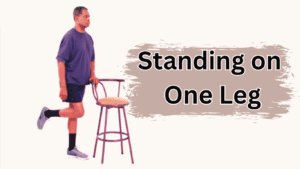
Safety Tips: Always keep a sturdy object within reach to grab onto if you lose your balance. Gradually increase the time you can balance on one leg as you become more comfortable.
Tandem Walking:
- Positioning: Stand with your feet together and your arms extended for balance.
- Walking: Walk forward in a straight line by placing the heel of one foot directly in front of the toes of the other foot, as if walking on a tightrope.
- Continuing: Take 10-15 steps forward, turn around, and walk back to the starting point.
- Repetition: Repeat this sequence 2-3 times.

Safety Tips: Perform this exercise along a hallway or with a wall nearby for support if needed. Keep your eyes focused on a fixed point ahead to help maintain balance.
Heel-to-Toe Walk:
- Positioning: Stand with your feet together and your arms extended for balance.
- Stepping: Step forward with your right foot, placing the heel directly in front of the toes of your left foot.
- Walking: Continue walking in a straight line, alternating feet for 10-15 steps.
- Repetition: Turn around and repeat the exercise 2-3 times.
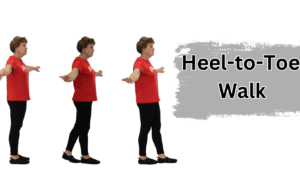
Safety Tips: Use a hallway or perform near a wall for support. Keep your gaze forward and avoid looking down at your feet to maintain balance.
Flexibility Exercises
Flexibility exercises are vital for maintaining the range of motion in your joints and preventing stiffness. Here are some effective stretching routines focusing on the legs.
Hamstring Stretches:
- Positioning: Sit on the edge of a sturdy chair with your right leg extended straight in front of you and your left foot flat on the ground.
- Stretching: Lean forward slightly from your hips, keeping your back straight, and reach towards your toes on the extended leg.
- Holding: Hold the stretch for 15-30 seconds without bouncing.
- Switching: Repeat the stretch with your left leg extended.
- Repetition: Perform 2-3 repetitions on each leg.
Benefits: This stretch improves flexibility in the hamstrings, which can help with activities like bending and walking.
Calf Stretches:
- Positioning: Stand facing a wall with your hands placed on the wall at shoulder height.
- Stretching: Step back with your right leg, keeping it straight and pressing your heel into the ground. Bend your left knee slightly and lean forward.
- Holding: Hold the stretch for 15-30 seconds.
- Switching: Repeat the stretch with your left leg.
- Repetition: Perform 2-3 repetitions on each leg.
Benefits: This stretch enhances flexibility in the calf muscles, aiding in movements like walking and climbing stairs.
Quadriceps Stretches:
- Positioning: Stand next to a chair or wall for support.
- Stretching: Bend your right knee and bring your heel towards your buttocks, holding your ankle with your right hand.
- Holding: Hold the stretch for 15-30 seconds, ensuring your knee points straight down.
- Switching: Repeat the stretch with your left leg.
- Repetition: Perform 2-3 repetitions on each leg.
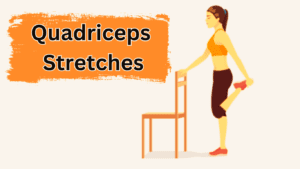
Benefits: This stretch improves flexibility in the quadriceps, which are essential for movements like standing up and climbing stairs.
Hip Flexor Stretches:
- Positioning: Stand with your feet hip-width apart.
- Stretching: Step back with your right foot into a lunge position, keeping your left knee bent and your right leg straight.
- Leaning: Lean forward slightly to feel a stretch in the front of your right hip.
- Holding: Hold the stretch for 15-30 seconds.
- Switching: Repeat the stretch with your left leg.
- Repetition: Perform 2-3 repetitions on each leg.
Benefits: This stretch enhances flexibility in the hip flexors, improving overall hip mobility and reducing the risk of lower back pain.
Inner Thigh Stretches:
- Positioning: Sit on the floor with your legs extended straight out in front of you.
- Stretching: Bring the soles of your feet together, allowing your knees to drop out to the sides.
- Leaning: Lean forward slightly from your hips, keeping your back straight, and gently press your knees towards the ground with your elbows.
- Holding: Hold the stretch for 15-30 seconds.
- Repetition: Perform 2-3 repetitions.
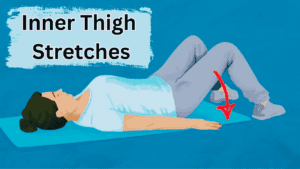
Benefits: This stretch improves flexibility in the inner thighs and groin, aiding in movements that require leg spreading.
Safety Tips for Stretching:
- Warm-Up: Always warm up with light activity, like walking, before stretching to prepare your muscles.
- Gentle Movements: Stretch slowly and gently, avoiding bouncing or jerky movements.
- Comfort Level: Stretch only to the point of mild tension, not pain. Overstretching can cause injury.
- Breathing: Breathe deeply and naturally throughout each stretch. Avoid holding your breath.
- Consistency: Incorporate flexibility exercises into your routine at least 3-4 times a week for the best results.
By incorporating balance and flexibility training alongside leg strengthening exercises for seniors, you can achieve a well-rounded fitness routine that promotes overall health and independence. Balance exercises will enhance your stability, reducing the risk of falls, while flexibility exercises will keep your muscles and joints supple, improving your ability to perform daily activities comfortably. Stay consistent with these practices, and you’ll enjoy a more active, confident, and fulfilling lifestyle.
Creating a Personalized Exercise Plan
Developing a personalized exercise plan is essential for effectively incorporating leg strengthening exercises for seniors into your routine. Tailoring your fitness regimen to match your individual needs and capabilities ensures you stay motivated and achieve the best results. This section will guide you through assessing your current fitness level, setting realistic goals, creating a balanced weekly plan, and tracking your progress.
Before starting any new exercise routine, it is crucial to assess your current fitness level. This helps in setting realistic goals and ensures that your exercise plan is both safe and effective.
How to Assess Your Fitness Level:
- Evaluate Your Strength: Begin by testing your ability to perform basic leg exercises such as chair squats, leg lifts, and heel raises. Note how many repetitions you can complete comfortably. This will help gauge your starting strength and endurance.
- Assess Balance: Test your balance by performing exercises like standing on one leg or tandem walking. Observe how long you can maintain each position without support. This assessment will indicate your current balance abilities and areas that may need improvement.
- Check Flexibility: Perform basic stretches, such as hamstring and calf stretches, to determine your flexibility level. Notice any areas of stiffness or discomfort, which will help you tailor your stretching routine to address these needs.
- Monitor Cardiovascular Fitness: Engage in a low-intensity cardio activity, such as walking, for a few minutes and monitor how you feel. Pay attention to your heart rate, breathing, and any signs of fatigue. This will help assess your cardiovascular fitness and endurance.
Setting Realistic Goals
Based on your initial assessment, set specific, measurable, achievable, relevant, and time-bound (SMART) goals. These goals will guide your exercise routine and help you stay motivated.
- Strength Goals: For instance, if you can comfortably perform 10 chair squats, aim to increase this number by 5-10 reps over the next few weeks. Setting incremental goals helps in gradual improvement and avoids overexertion.
- Balance Goals: If you can only balance on one leg for 5 seconds, aim to increase this time by 5-10 seconds each week. Gradual progression in balance exercises will enhance stability and reduce fall risk.
- Flexibility Goals: If you can only stretch your hamstrings to a certain point, set a goal to improve your reach by a few inches over a specified period. Regular stretching will enhance flexibility and overall comfort.
- Cardiovascular Goals: If you can walk for 10 minutes without discomfort, aim to gradually increase your walking duration by 5 minutes each week. Improved cardiovascular endurance will enhance overall fitness.
Sample Weekly Exercise Plan
A well-rounded exercise plan for seniors should balance strength, flexibility, and balance exercises. Here’s a sample weekly plan to get you started:
Monday: Strength and Balance
- Chair Squats: 2 sets of 10-15 reps
- Standing on One Leg: 2 sets of 20-30 seconds per leg
- Calf Raises: 2 sets of 10-15 reps
- Tandem Walking: 2-3 sets of 10-15 steps forward and backward
Tuesday: Flexibility
- Hamstring Stretches: 2 sets of 15-30 seconds per leg
- Calf Stretches: 2 sets of 15-30 seconds per leg
- Quadriceps Stretches: 2 sets of 15-30 seconds per leg
- Hip Flexor Stretches: 2 sets of 15-30 seconds per leg
Wednesday: Cardio and Core
- Walking: 20-30 minutes at a comfortable pace
- Seated Marching: 2 sets of 20-30 reps
- Seated Leg Press with Resistance Band: 2 sets of 10-15 reps
Thursday: Balance and Flexibility
- Heel-to-Toe Walk: 2-3 sets of 10-15 steps forward and backward
- Inner Thigh Stretches: 2 sets of 15-30 seconds
- Standing on One Leg: 2 sets of 20-30 seconds per leg
- Hip Flexor Stretches: 2 sets of 15-30 seconds per leg
Friday: Strength and Cardio
- Step-Ups: 2 sets of 10-15 reps per leg
- Resistance Band Exercises (Seated Leg Press): 2 sets of 10-15 reps
- Walking: 20-30 minutes at a comfortable pace
Saturday: Recovery and Light Activity
- Gentle Stretching: 15-20 minutes focusing on any tight areas
- Light Activity: Engage in a leisure activity like gardening or light household chores
Sunday: Rest Day
- Rest and Recovery: Allow your body to rest and recover. This is essential for muscle repair and overall well-being.
Tracking Progress
Tracking your progress helps in staying motivated and making necessary adjustments to your exercise plan.
How to Track Your Progress:
- Exercise Log: Maintain a journal or digital log of your workouts. Record the exercises performed, sets, repetitions, and any notes on how you felt during each session. This will help you monitor improvements and identify areas needing adjustment.
- Goal Review: Regularly review your goals and assess your progress. For example, if your goal was to increase the number of chair squats, note how many you can perform now compared to the start.
- Adjustments: Based on your progress, make adjustments to your plan. If you find certain exercises becoming too easy, increase the intensity or duration. Conversely, if an exercise is too challenging, consider modifying it or reducing the volume.
- Feedback: Pay attention to feedback from your body. If you experience persistent discomfort or pain, re-evaluate your technique or consult a healthcare provider. Adjust your routine as needed to ensure it remains safe and effective.
- Celebrating Milestones: Celebrate your achievements, no matter how small. Recognizing and rewarding yourself for reaching milestones will keep you motivated and committed to your exercise routine.
Quick Reference Guide for Senior Leg Strengthening Exercises
| Exercise | Target Muscles | Key Benefits | Suggested Frequency | Common Modifications | Safety Tips |
|---|---|---|---|---|---|
| Chair Squats | Quadriceps, Hamstrings, Glutes | Improves standing/sitting ability, enhances lower body strength | 3-4 times/week | Use chair for support; partial squats | Keep knees aligned with toes; avoid deep bending |
| Leg Lifts | Hip Flexors, Core | Enhances leg strength, improves balance | 3-4 times/week | Perform seated if balance is an issue | Avoid leaning; maintain straight posture |
| Heel & Toe Raises | Calves | Strengthens calves, improves balance | Daily | Perform seated if needed | Use support if unsteady; controlled movements |
| Seated Marching | Hip Flexors, Quads | Boosts circulation, improves mobility | Daily | Lift legs only as high as comfortable | Keep feet flat when starting; increase height gradually |
| Step-Ups | Quadriceps, Hamstrings, Glutes | Mimics stair climbing, enhances coordination | 3 times/week | Use handrail for support; lower step height | Ensure platform stability; step carefully |
| Resistance Band Press | Quads, Hamstrings, Glutes | Strengthens legs with adjustable resistance | 2-3 times/week | Reduce band tension for ease | Secure band properly to prevent snapping |
| Wall Sits | Quadriceps, Glutes | Improves endurance, enhances stability | 2-3 times/week | Hold for shorter periods initially | Keep back flat; don’t let knees extend past toes |
Creating a personalized exercise plan that includes leg strengthening exercises for seniors, along with balance and flexibility training, will lead to improved physical health and enhanced quality of life. By assessing your fitness level, setting realistic goals, following a balanced weekly plan, and tracking your progress, you can achieve lasting benefits and maintain a high level of independence. Stay consistent with your plan, listen to your body, and enjoy the journey towards better health and well-being.
Staying Motivated and Engaged in Your Exercise Routine
When incorporating leg strengthening exercises for seniors into your daily life, staying motivated and engaged is crucial for achieving long-term success. Without a clear sense of purpose and enjoyment, it can be challenging to maintain a consistent exercise routine. This section will cover how to set effective goals, find support, and make your exercise routine enjoyable, ensuring you stay committed to your fitness journey.
Setting Goals
Setting goals is a powerful way to stay motivated and track your progress with leg strengthening exercises for seniors. Both short-term and long-term goals provide direction and a sense of accomplishment.
Importance of Setting Short-Term Goals:
- Immediate Focus: Short-term goals are achievable within a few weeks to a month and help keep your focus on immediate tasks. For example, if your current goal is to complete 10 chair squats, a short-term goal might be to increase this number to 15 within the next two weeks.
- Boost Motivation: Achieving short-term goals provides a sense of accomplishment and encourages you to continue with your exercise routine. These small victories keep you motivated and boost your confidence.
- Track Progress: Short-term goals allow you to monitor improvements in your strength, balance, and flexibility. Regularly hitting these goals indicates that your exercise routine is effective and helps adjust your plan if needed.
Importance of Setting Long-Term Goals:
- Vision for the Future: Long-term goals focus on broader achievements and provide a vision for what you want to accomplish over several months or even years. For instance, a long-term goal might be to improve your overall leg strength to the point where you can comfortably walk for 30 minutes without discomfort.
- Sustained Motivation: Long-term goals keep you motivated by giving you a larger objective to work towards. They offer a sense of purpose and help you stay committed to your fitness routine.
- Guide Your Plan: Long-term goals help shape your exercise plan, allowing you to set intermediate milestones and adjust your routines to achieve these broader objectives.
Finding Support
Support from others can significantly enhance your motivation and enjoyment of leg strengthening exercises for seniors. Connecting with others who share your fitness goals or seeking encouragement from friends and family can make a difference.
Finding a Workout Buddy:
- Shared Motivation: Exercising with a buddy can make workouts more enjoyable and provide mutual encouragement. A workout partner can help you stay accountable and committed to your exercise routine.
- Social Interaction: Having someone to share your fitness journey with can make exercise sessions more engaging and less monotonous. Social interaction can also improve your mood and make workouts feel less like a chore.
- Safety and Support: A workout buddy can provide support in case of any physical challenges or safety concerns during exercises, ensuring that you perform movements correctly and safely.
Joining a Fitness Class:
- Structured Routine: Fitness classes designed for seniors offer a structured exercise routine led by a professional instructor. These classes provide guidance on performing leg strengthening exercises for seniors correctly and safely.
- Community Engagement: Participating in group classes allows you to connect with others who have similar fitness goals. This sense of community can enhance motivation and create a supportive environment.
- Variety and Fun: Classes often include a variety of exercises, which can make your routine more interesting and enjoyable. The social aspect of classes also adds an element of fun to your workouts.
Using Online Communities:
- Virtual Support: Online communities and forums dedicated to senior fitness provide access to a wide range of resources, including exercise tips, success stories, and motivational support. Engaging with these communities can offer encouragement and valuable advice.
- Access to Resources: Many online platforms offer virtual exercise classes and tutorials specifically designed for seniors. These resources can help you learn new exercises and techniques from the comfort of your home.
- Accountability: Online groups often have regular challenges or check-ins that can help you stay accountable to your fitness goals. Sharing your progress and receiving feedback from others can keep you motivated.
Making It Fun
Finding ways to make your exercise routine enjoyable is essential for maintaining long-term engagement with leg strengthening exercises for seniors. Incorporating elements of fun and variety can make workouts feel less like a task and more like an enjoyable activity.
Listening to Music:
- Enhanced Enjoyment: Listening to your favorite music during workouts can make the experience more enjoyable and boost your energy levels. Music has the power to elevate your mood and make exercise sessions feel less strenuous.
- Pacing and Rhythm: Music can help you maintain a steady pace and rhythm during exercises. Upbeat tunes can keep you motivated and make the time pass more quickly.
- Personalized Playlist: Create a playlist with songs that you find motivating and energizing. Tailoring your music to your preferences can enhance the overall workout experience.
Varying Your Routine:
- Prevent Boredom: Changing up your exercise routine regularly can prevent boredom and keep you engaged. Incorporate different types of leg strengthening exercises for seniors, such as chair squats, leg lifts, and balance exercises, to keep your workouts fresh and exciting.
- Challenge Yourself: Varying your routine introduces new challenges and helps you continue progressing. For example, you might try incorporating resistance bands or using different types of balance exercises to keep things interesting.
- Explore New Activities: Occasionally, try new activities or exercises that you haven’t done before. This could include trying a new fitness class or exploring different types of outdoor activities. Exploring new options can add an element of excitement to your fitness routine.
Setting Up a Reward System:
- Celebrate Milestones: Establish a reward system for achieving both short-term and long-term goals. Rewards can be as simple as treating yourself to a favorite activity or enjoying a special treat. Recognizing and celebrating your achievements can boost motivation and create positive reinforcement.
- Track Progress: Use a fitness journal or app to track your progress and set new goals. Seeing how far you’ve come can be motivating and help you stay committed to your routine.
- Share Achievements: Share your progress and achievements with friends or family members. Positive reinforcement from loved ones can provide additional encouragement and support.
Staying motivated and engaged with leg strengthening exercises for seniors involves setting clear goals, seeking support, and finding ways to make your routine enjoyable. By setting both short-term and long-term goals, you provide yourself with direction and purpose. Finding support through workout buddies, fitness classes, or online communities can enhance your motivation and make exercising more enjoyable. Incorporating fun elements such as listening to music and varying your routine ensures that your workouts remain engaging and satisfying.
By following these strategies, you’ll be better equipped to maintain a consistent exercise routine, achieve your fitness goals, and enjoy the many benefits of a stronger, healthier body. Stay positive, keep experimenting with different approaches, and celebrate your progress along the way.
Addressing Challenges and Providing Solutions for Leg Strengthening Exercises
Engaging in leg strengthening exercises for seniors can be incredibly beneficial, but it’s not uncommon to face challenges along the way. These challenges can range from joint pain to a lack of motivation, or even limited mobility. Understanding these obstacles and knowing how to address them is crucial for maintaining a consistent and effective exercise routine. This section will explore common issues seniors might encounter and provide practical solutions to help overcome these challenges.
Common Obstacles for leg strengthening exercises for seniors
Joint Pain:
Joint pain is a common issue that many seniors face, and it can be a significant barrier to engaging in leg strengthening exercises for seniors. Pain in the knees, hips, or ankles can make certain movements uncomfortable or even unbearable.
- Impact on Exercise: Joint pain can limit your ability to perform exercises that involve weight-bearing or repetitive movements. This discomfort can deter you from maintaining a regular exercise routine.
- Pain Management: Joint pain may be due to conditions like arthritis or general wear and tear. Managing this pain is essential to ensure that you can continue exercising safely.
Lack of Motivation:
Maintaining motivation can be a challenge, especially if you’re new to exercise or if progress seems slow. It’s easy to lose enthusiasm if you don’t see immediate results or if exercise feels like a chore.
- Declining Interest: Over time, the novelty of a new exercise routine can wear off, leading to decreased interest and motivation.
- Goal Setting: Without clear goals and milestones, it can be challenging to stay motivated and committed to a regular exercise routine.
Limited Mobility:
Limited mobility can affect your ability to perform certain exercises. Conditions such as arthritis, muscle weakness, or recovery from injury can make movement more difficult.
- Difficulty with Movement: Exercises that require bending, stretching, or standing may become challenging, impacting your ability to perform a full range of leg strengthening activities.
- Modifications Required: Seniors with limited mobility often need modified exercises or alternative methods to achieve similar benefits without causing discomfort or risking injury.
Solutions and Adaptations for leg strengthening exercises for seniors
Managing Joint Pain:
1. Low-Impact Exercises: Opt for low-impact exercises that reduce stress on the joints while still providing a good workout. Swimming, water aerobics, and cycling on a stationary bike are excellent alternatives that are gentle on the joints.
2. Use Proper Equipment: Supportive shoes and cushioned mats can help reduce joint impact during exercises. For instance, using a padded mat during floor exercises or wearing supportive footwear during walking can alleviate discomfort.
3. Warm-Up and Cool-Down: Incorporate thorough warm-up and cool-down routines to prepare your joints for exercise and aid in recovery. Gentle stretching and low-intensity movements can help improve flexibility and reduce stiffness.
4. Consult a Professional: Working with a physical therapist or a fitness professional who specializes in senior fitness can help tailor exercises to manage joint pain effectively. They can recommend specific exercises that strengthen the muscles around the joints and offer personalized advice.
Addressing Lack of Motivation:
1. Set Achievable Goals: Break down your long-term goals into smaller, manageable short-term goals. Celebrate each achievement to stay motivated and recognize your progress. For example, if your goal is to increase the number of chair squats, start with a small number and gradually increase.
2. Find a Workout Buddy: Exercising with a friend or family member can make the experience more enjoyable and provide mutual encouragement. A workout buddy can help you stay accountable and make exercise sessions more social and fun.
3. Incorporate Enjoyable Activities: Choose exercises and activities that you find enjoyable. Whether it’s listening to music, joining a dance class, or engaging in light outdoor activities, incorporating elements you like can enhance motivation and make exercising feel less like a task.
4. Track Your Progress: Keep a journal or use a fitness app to track your exercise routine and progress. Seeing how far you’ve come and the improvements you’ve made can boost motivation and help you stay committed to your fitness plan.
Overcoming Limited Mobility:
1. Modified Exercises: Adapt exercises to accommodate your level of mobility. For example, if standing exercises are challenging, perform seated versions or use a chair for support during balance exercises. Seated leg lifts and chair squats are effective alternatives that can still provide significant benefits.
2. Focus on Range of Motion: Engage in exercises that emphasize gentle stretching and improving range of motion. Stretching exercises like seated hamstring stretches and gentle calf stretches can enhance flexibility and reduce stiffness.
3. Use Supportive Tools: Utilize tools such as resistance bands or exercise balls that can assist with mobility and provide support. Resistance bands can be used for seated leg presses and other exercises that require minimal movement but still offer resistance.
4. Seek Professional Guidance: A physical therapist can provide personalized exercise recommendations that cater to your mobility limitations. They can help design a program that enhances your strength and flexibility while considering any physical constraints.
Additional Tips for Success
**1. Be Patient and Consistent: Progress may be gradual, especially when dealing with joint pain or limited mobility. Be patient with yourself and maintain a consistent routine to see long-term benefits. Consistency is key to improving strength and mobility over time.
**2. Listen to Your Body: Pay attention to how your body responds to different exercises. If you experience pain or discomfort, adjust the exercise or seek advice from a healthcare professional. It’s essential to distinguish between discomfort from exertion and pain that signals a potential problem.
**3. Incorporate Rest Days: Allow adequate time for rest and recovery to prevent overuse injuries and give your muscles and joints time to heal. Rest days are crucial for maintaining overall health and preventing burnout.
**4. Stay Educated: Continuously educate yourself about effective exercises and strategies for managing challenges. Staying informed can help you make better decisions about your exercise routine and adapt to changing needs.
Addressing the challenges associated with leg strengthening exercises for seniors involves understanding common obstacles such as joint pain, lack of motivation, and limited mobility. By implementing practical solutions and adaptations, you can overcome these barriers and maintain a consistent and effective exercise routine. Embrace low-impact exercises, set achievable goals, find support, and modify activities to suit your mobility level. With patience, consistency, and the right strategies, you can enjoy the benefits of a stronger, more flexible body and enhance your overall quality of life.
Embracing the Benefits of Leg Strengthening Exercises for Seniors
As we conclude this comprehensive guide on leg strengthening exercises for seniors, it’s essential to reflect on the invaluable benefits these exercises can bring to your life. Incorporating these exercises into your daily routine not only enhances your leg strength but also contributes to improved mobility, balance, and overall quality of life. It’s time to take the insights and strategies discussed and transform them into action, ensuring a healthier and more fulfilling life.
The Power of Leg Strengthening Exercises for Seniors
The importance of leg strengthening exercises for seniors cannot be overstated. These exercises serve as a cornerstone for maintaining independence and improving your overall well-being. Strengthening your legs contributes to better balance, which is crucial in preventing falls and reducing the risk of injury. Improved leg strength also supports enhanced mobility, allowing you to move more confidently and engage in daily activities with greater ease.
Incorporating a range of leg strengthening exercises into your routine can also positively impact your cardiovascular health and overall physical fitness. Exercises such as chair squats, leg lifts, and step-ups are designed to build strength, increase endurance, and improve flexibility. By committing to these exercises, you’re not only investing in your physical health but also in your mental and emotional well-being.
Taking the First Step
Starting an exercise routine can be daunting, but taking the first step is crucial. Begin by consulting with your healthcare provider to ensure that your exercise plan is safe and appropriate for your current health condition. Your healthcare provider can offer personalized advice and help you set realistic goals based on your fitness level and any existing medical conditions.
Once you have your healthcare provider’s approval, start with exercises that feel comfortable and manageable. Remember, progress takes time, and it’s important to approach your routine with patience and persistence. Focus on incorporating exercises that you enjoy and that align with your fitness goals. Whether it’s chair squats, heel raises, or resistance band exercises, find what works best for you and stick with it.
Building Your Routine of Leg Strengthening Exercises for Seniors
As you begin to build your exercise routine, it’s essential to stay motivated and consistent. Set short-term goals to track your progress and celebrate small victories along the way. This approach will help you stay engaged and encouraged as you work towards your long-term fitness objectives. Find ways to make your workouts enjoyable, such as listening to music or joining a fitness class designed for seniors.
If you encounter obstacles, such as joint pain or limited mobility, remember that modifications and alternative exercises can still provide significant benefits. Adapt your routine to address these challenges and consult with fitness professionals if needed. They can offer guidance and adjustments to ensure that your exercises are both safe and effective.
Seeking Support and Community
Finding support and connecting with others can enhance your motivation and commitment to leg strengthening exercises for seniors. Whether it’s working out with a friend, joining a fitness class, or participating in an online community, engaging with others who share similar goals can provide encouragement and accountability.
Consider exploring local senior fitness programs or online forums where you can exchange experiences, seek advice, and celebrate achievements with others. The social aspect of exercising can make your routine more enjoyable and help you stay on track.
Further Reading and Resources
For those looking to deepen their understanding of leg strengthening exercises for seniors and explore additional resources, here are some credible sources:
- American College of Sports Medicine (ACSM): The ACSM offers guidelines and recommendations for physical activity and exercise for older adults. Their resources can provide valuable insights into safe and effective exercise practices.
- National Institute on Aging (NIA): The NIA provides information on the benefits of physical activity and tips for older adults to stay active and healthy.
- Centers for Disease Control and Prevention (CDC): The CDC offers guidelines and recommendations for physical activity and exercise for older adults, including tips for improving balance and preventing falls.
- Mayo Clinic: The Mayo Clinic provides a wealth of information on exercises for seniors, including recommendations for strength training and flexibility.
Embarking on the journey of leg strengthening exercises for seniors is a powerful decision that can lead to improved physical health and a higher quality of life. Embrace this opportunity to enhance your leg strength, mobility, and balance. Remember that every step you take towards incorporating these exercises into your routine is a step towards greater independence and well-being.
Stay positive and persistent, and don’t hesitate to seek support from healthcare professionals, fitness experts, and supportive communities. The benefits of regular exercise extend far beyond physical health, enriching your life with confidence, vitality, and a sense of accomplishment.
Begin today by consulting with your healthcare provider, setting achievable goals, and integrating the exercises that best suit your needs and preferences. With dedication and the right approach, you’ll experience the transformative impact of leg strengthening exercises for seniors and enjoy a more active, vibrant, and fulfilling life.


